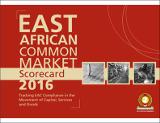| dc.description.abstract | The East Africa Community (EAC) is already the most integrated regional bloc in Africa. While intra-African trade as a percentage of total trade is not as high as high as the dynamic ASEAN bloc, the EAC’s nearly 25 percent intra-EAC export is impressive when
compared to other developing regional blocs (See Figure 1). Since establishing the EAC Customs Union in 2005, EAC Partner States have worked to harness their joint economic potential by eliminating barriers to intra-EAC trade and investment through implementation of the EAC Common Market Protocol (CMP) on the establishment
of the common market, which came into force in July 2010. Partner States - Burundi, Kenya, Rwanda, Tanzania, and Uganda – haveadopted the Common Market Scorecard (CMS) as a monitoring tool for the implementation of the CMP. The CMS is a tool that measures legal compliance with commitments undertaken under the CMP. The
CMS aims to further EAC integration with a view to increasing its economic potential and realizing much-needed improvements in the investment climate. Since the publication of the first CMS in 2014, the EAC expanded its membership, welcoming South Sudan as a
sixth member in 2016. | en_US |

